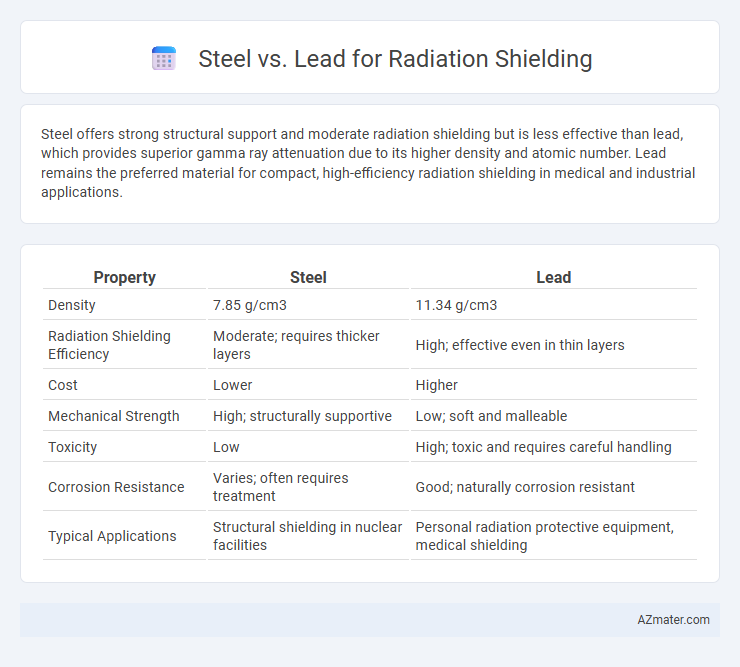Steel offers strong structural support and moderate radiation shielding but is less effective than lead, which provides superior gamma ray attenuation due to its higher density and atomic number. Lead remains the preferred material for compact, high-efficiency radiation shielding in medical and industrial applications.
Table of Comparison
| Property | Steel | Lead |
|---|---|---|
| Density | 7.85 g/cm3 | 11.34 g/cm3 |
| Radiation Shielding Efficiency | Moderate; requires thicker layers | High; effective even in thin layers |
| Cost | Lower | Higher |
| Mechanical Strength | High; structurally supportive | Low; soft and malleable |
| Toxicity | Low | High; toxic and requires careful handling |
| Corrosion Resistance | Varies; often requires treatment | Good; naturally corrosion resistant |
| Typical Applications | Structural shielding in nuclear facilities | Personal radiation protective equipment, medical shielding |
Overview of Radiation Shielding Materials
Steel and lead are common materials used for radiation shielding, each offering distinct protective properties. Lead provides superior attenuation of gamma rays and X-rays due to its high density and atomic number, making it highly effective in compact shielding applications. Steel, while less dense, offers structural strength and durability, often utilized where mechanical support is necessary alongside moderate radiation attenuation.
Key Properties of Steel and Lead
Steel offers structural strength, durability, and moderate radiation attenuation, with a density around 7.85 g/cm3 and a high melting point near 1370degC, making it suitable for combined shielding and mechanical support. Lead's high density (11.34 g/cm3) and atomic number (Z=82) provide superior gamma ray and X-ray attenuation compared to steel, though it is softer and more prone to deformation. Both materials differ in shielding effectiveness, with lead excelling at radiation protection and steel preferred where mechanical strength and toughness are critical.
Radiation Attenuation Capabilities
Lead offers superior radiation attenuation capabilities compared to steel due to its higher atomic number (82) and density (11.34 g/cm3), enabling more effective absorption of gamma rays and X-rays. Steel, with a lower atomic number (26) and density (~7.85 g/cm3), requires greater thickness to achieve comparable shielding performance. The choice between steel and lead depends on application-specific factors such as weight constraints, structural requirements, and cost efficiency in radiation shielding design.
Density and Thickness Requirements
Lead offers superior radiation shielding due to its high density of 11.34 g/cm3, allowing for thinner barriers compared to steel, which has a density around 7.85 g/cm3. Steel requires greater thickness to achieve equivalent attenuation because its lower density results in less mass per unit volume to absorb radiation. For gamma rays and X-rays, lead shields can be 30-50% thinner than steel shields while maintaining effective protection.
Durability and Longevity in Shielding
Steel offers superior durability and structural integrity for radiation shielding, maintaining its strength and shape under harsh environmental conditions and mechanical stress. Lead, while highly effective at attenuating radiation due to its high density, is softer and prone to deformation, corrosion, and wear over time, which can compromise its protective capabilities. Steel's resistance to corrosion and mechanical damage contributes to longer-lasting radiation shielding solutions, making it ideal for applications requiring sustained performance and minimal maintenance.
Health and Environmental Impact
Steel offers effective radiation shielding with lower toxicity and is more environmentally sustainable compared to lead, which poses significant health risks due to its neurotoxicity and potential for bioaccumulation. Lead exposure can cause severe health issues including neurological damage and contamination of soil and water, whereas steel's recyclability reduces environmental impact. Choosing steel over lead enhances workplace safety and aligns with eco-friendly practices in radiation protection.
Installation and Structural Considerations
Steel offers superior structural strength for radiation shielding installations, supporting heavy loads and allowing thinner shielding walls compared to lead. Lead's high density provides excellent radiation attenuation but requires additional structural support due to its softness and weight, increasing installation complexity and cost. Selecting steel minimizes the need for reinforced frameworks, streamlining construction and ensuring long-term durability in shielding applications.
Cost Comparison: Steel vs Lead
Steel offers a cost-effective alternative to lead for radiation shielding, with lower material costs and higher availability driving reduced overall expenses. Lead's higher density provides superior shielding per unit thickness, but its price volatility and toxicity contribute to increased handling and disposal costs. Considering lifecycle expenses, steel's durability and recyclability often result in more economical long-term shielding solutions compared to lead.
Industry Applications and Use Cases
Steel offers superior structural strength and durability, making it ideal for radiation shielding in nuclear power plants, medical imaging facilities, and industrial radiography where mechanical integrity is crucial. Lead provides excellent density and radiation attenuation, commonly used in diagnostic imaging rooms, radiotherapy units, and portable radiation protection devices due to its ease of shaping and high shielding efficiency. Industry applications often combine steel and lead layers to optimize protection, balancing mechanical support and radiation attenuation across diverse use cases.
Future Trends in Radiation Shielding Materials
Future trends in radiation shielding materials emphasize the development of novel composites combining steel's structural strength with lead's superior gamma radiation attenuation. Emerging materials incorporate high-density, non-toxic alternatives like tungsten-infused polymers and advanced metal matrix composites to replace traditional lead shields. Research prioritizes lightweight, corrosion-resistant, and environmentally friendly solutions to enhance protective performance in medical, nuclear, and aerospace applications.

Infographic: Steel vs Lead for Radiation Shielding
 azmater.com
azmater.com